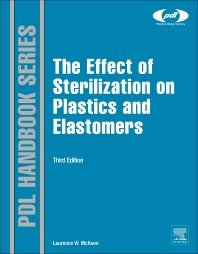Freshly Printed - allow 10 days lead
Couldn't load pickup availability
The Effect of Sterilization on Plastics and Elastomers
Essential data and best practice guidance for engineers and product designers working in the plastics industry, and industry sectors that utilize plastics in sterile environments, such as packaging (food, pharmaceuticals, healthcare products, etc.), medical devices, chemical processing, agriculture and defense.
Laurence W. McKeen (Author)
9781455725984, Elsevier Science
Hardback, published 25 September 2012
480 pages
27.6 x 21.5 x 2.9 cm, 1.06 kg
This reference guide brings together a wide range of essential data on the sterilization of plastics and elastomers, enabling engineers to make optimal material choices and design decisions. The data tables in this book enable engineers and scientists to select the right materials, and right sterilization method for a given product or application. The third edition includes new text chapters that provide the underpinning knowledge required to make best use of the data. Larry McKeen has also added detailed descriptions of sterilization methods for most common polymer classes such as polyolefins, polyamides, polyesters, elastomers, fluoropolymers, biodegradable plastics. Data has been updated throughout, with expanded information on newer classes of polymer utilized in medical devices and sterile packaging, such as UHMWPE, high temperature plastics (PEEK, PES, PPS, etc.), PBT, PETG, etc. The resulting Handbook is an essential reference for Plastics Engineers, Materials Scientists and Chemists working in contexts where sterilization is required, such as food packaging, pharmaceutical packaging and medical devices.
Appendices
Subject Areas: Other manufacturing technologies [TDP], Rubber technology [TDCR], Plastics & polymers technology [TDCP], Chemical engineering [TDCB]


